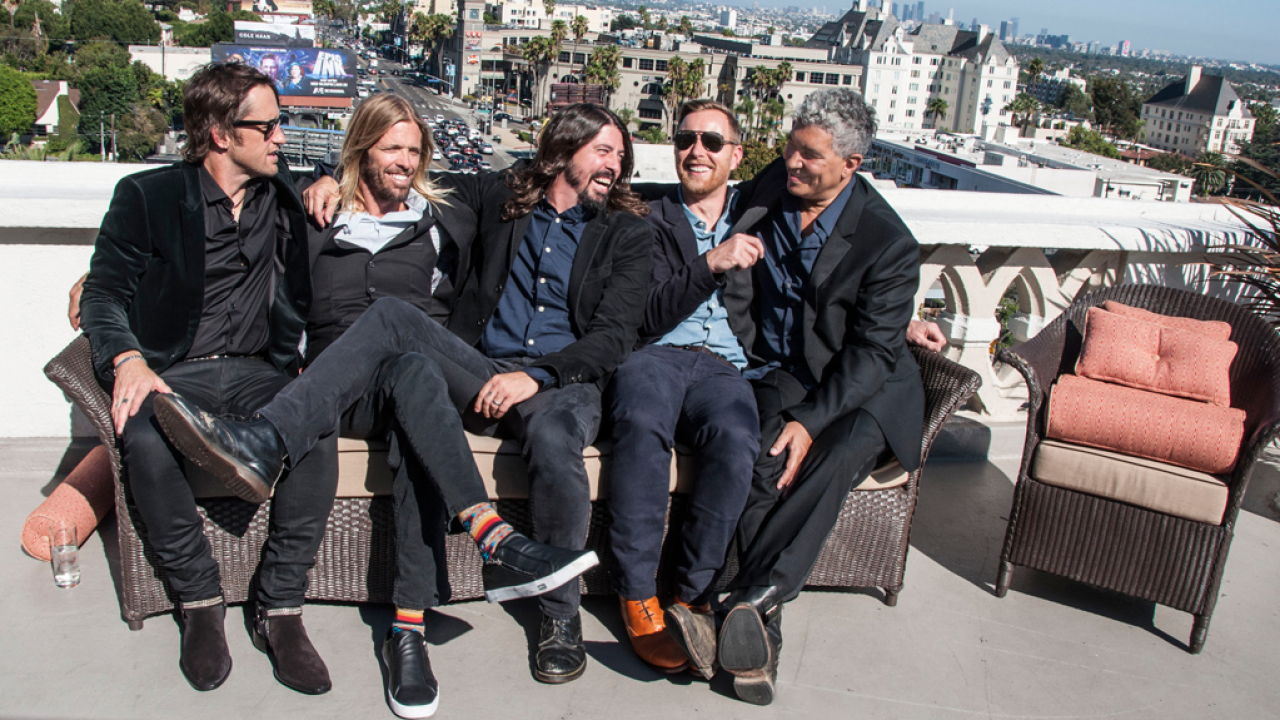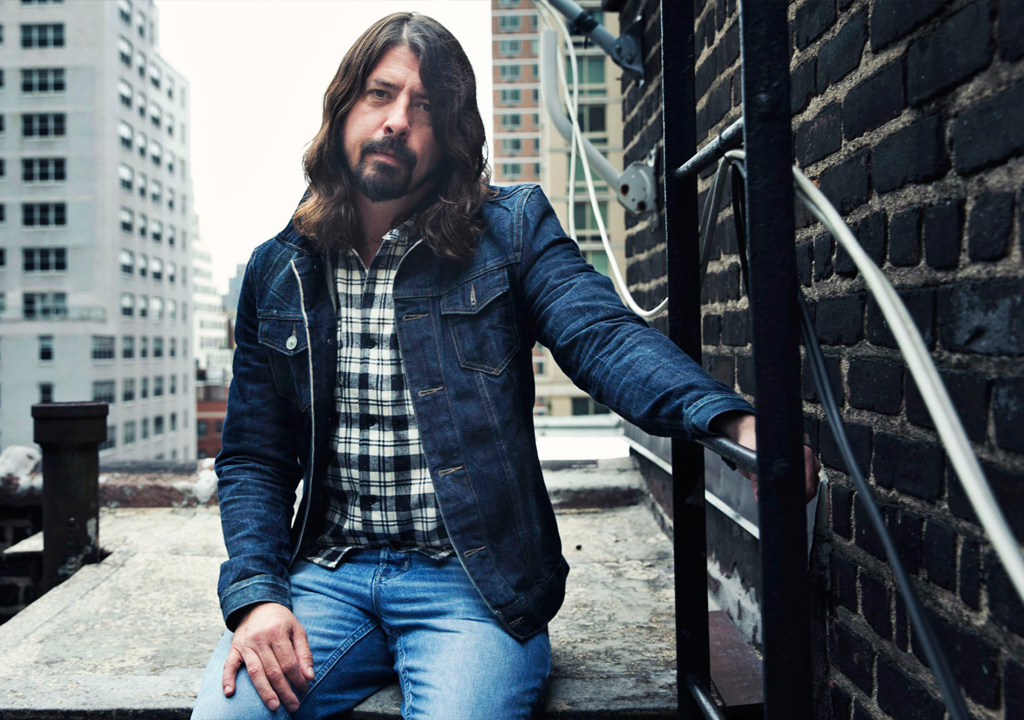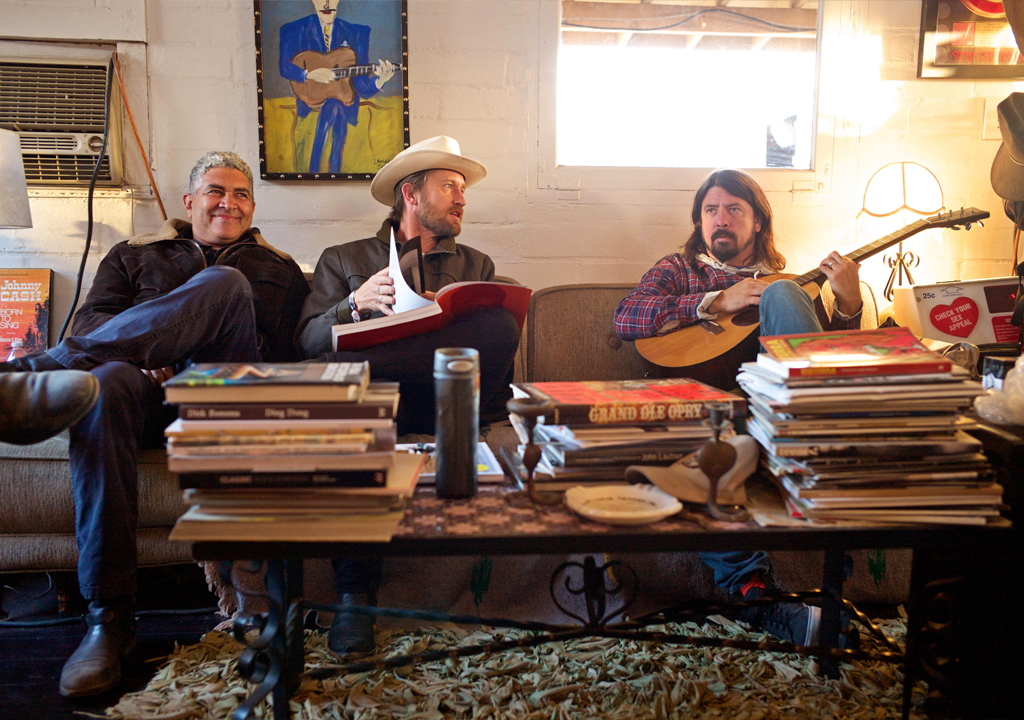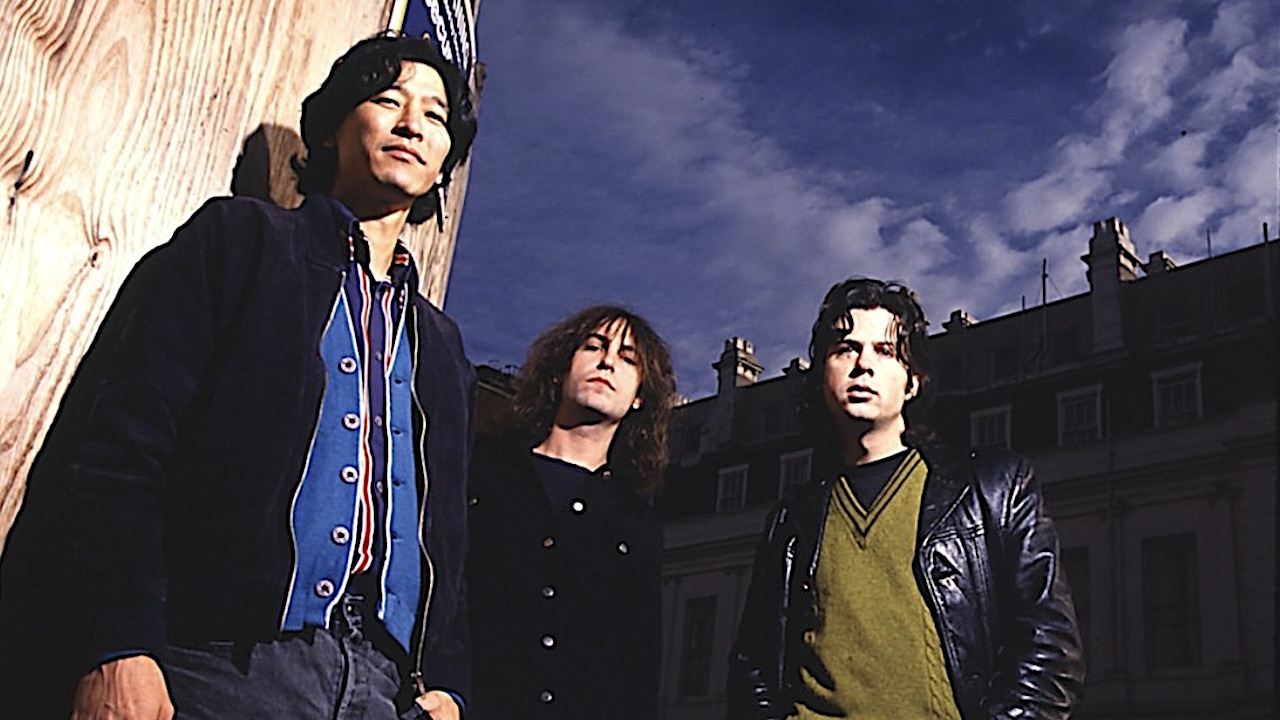Foo Fighters: Multi-Taskers Of 2014
A new album, a documentary and a chat with the President? Business as usual for the ever-prolific Dave Grohl.

Dave Grohl doesn’t really go in for anniversaries. Which probably explains why he’s struggling to process the fact that 2014 signalled two decades since he put together Foo Fighters. “Anniversaries are strange, because they’re markers that sort of pull you back,” he says. “I like them as these little trophies of achievement – ‘Oh, you survived, yeah!’ – but it’s funny to try to imagine the last 20 years. It’s a little blurry.”
You can forgive his blurriness. This has been a particularly exhaustive year, even by Grohl’s own prolific standards. First there was the matter of a new Foos album, an ambitious undertaking that saw the band recording songs in eight American cities. This activity ran parallel to (and took its name from) Sonic Highways, an eight-part HBO series on US TV, directed by Grohl, in which he interviewed famous musicians at each port of call. He even wrangled a visit to the White House, where he sat down for a chinwag with President Obama.
The project, which Grohl calls “a love letter to the history of American music”, involved stop-offs in Chicago, Austin, Nashville, LA, Seattle, New Orleans, Washington DC and New York. The list of interviewees include Dolly Parton, Paul Stanley, Joe Walsh, Willie Nelson, Steve Albini, Nancy Wilson, Cheap Trick’s Rick Nielsen, Fugazi man Ian MacKaye and blues newcomer Gary Clark Jr. It’s very much a travelogue extension of Sound City, Grohl’s 2013 documentary about the legendary LA studio in which classic recordings by the likes of Neil Young, Fleetwood Mac, Leon Russell, Johnny Cash, Metallica and QOTSA were made, and where Nirvana cut Nevermind in the summer of 1991.
Foo Fighters’ return to action also brought a handful of live shows, chief among them being a headline slot at the Invictus Games, and a covert gig in Brighton where the band were billed as The Holy Shits. Factor in Nirvana’s induction into the Rock And Roll Hall Of Fame in April and it’s been a pretty hectic 12 months for Grohl.
This bout of multitasking shouldn’t surprise anyone who has followed Grohl’s career from the off. He’s a man for whom reinvention has always been key, whether it’s making the transition from drummer to frontman, forming supergroups with ex-members of Led Zeppelin, directing films or lending his talents to such disparate people as QOTSA and Puff Daddy. At the heart of it all is an understanding that in order to evolve, rock’n’roll must make exacting demands of itself.
“After twenty years, you have to imagine that it’s fun to make things different and to challenge yourself,” Grohl argues. “The last Foo Fighters record, Wasting Light [2011], was made in my garage. That was the same idea: I wanted to take the band out of its comfortable environment. We were trying to make a small garage sound halfway decent. So the challenge of the environment inspired the music. And the Sonic Highways project is just an extension of that same idea: how can we do that times eight? How can we go to eight different places? ’Cos some of the places we went to weren’t even studios.”
Perhaps the best illustration of this methodology is In The Clear, recorded in New Orleans’ Preservation Hall. The building dates back to the 18th century and was formerly a Spanish hotel, and then a portrait gallery, before it became a crucible of the local jazz scene. It even has its own resident group, the Preservation Hall Jazz Band, who also fetched up as guests on the Foos track.
Sign up below to get the latest from Classic Rock, plus exclusive special offers, direct to your inbox!
“They play three shows a day there,” Grohl explains. “They set up these church pew benches, the band walks in and plays; there are no microphones and no electricity. So to record in that room we had to build a studio. It sounds like such a burden, but it’s that challenge that makes you excited and gets you really inspired. You walk into the room and go: ‘Oh my God, this is fucking crazy! We’re going to record in here?’ Then you have only a few days to record the music and I have one night to write all the lyrics.”
Grohl may well have envisioned the concept of the album and the documentary series as an overarching whole, but how did his bandmates take to the idea? “When we were doing the Sound City shows in support of Dave’s movie, it was fun because we weren’t doing Foo Fighters songs,” recalls lead guitarist Chris Shiflett. “We were backing up John Fogerty and Stevie Nicks and Rick Springfield. It was like we got to go out and be a really badass cover band for a while. And somewhere around the end of that, Dave came in and said: ‘I’ve got this idea for how we should do the next record.’ I didn’t even blink, it just seemed like a cool idea. Because in recent years, Dave’s ideas became bigger.”
For Shiflett, the New Orleans experience was particularly memorable. Playing alongside album guests such as Joe Walsh, Rick Nielsen and Gary Clark Jr was one thing, but unexpectedly bumping into totemic musical heroes was another: “In New Orleans I was in the studio having a cup of coffee, first thing in the morning, and all of a sudden Allen Toussaint walks in. I didn’t even know that Dave was interviewing him. He’s standing right in front of me and I’m like, ‘Oh my God!’ I mean, what do you say?”
Meanwhile, it probably comes as no surprise to discover that shooting the breeze with Barack Obama was a particular highlight for Grohl. “The day that I interviewed him he had a press conference where he was announcing he was putting more troops back in Iraq,” he recalls. “It was a huge announcement, and then he gave the Congressional Medal Of Honour to a solider who sacrificed his body to save some other soldier. It was an incredibly emotional ceremony. He’s got the economy, he’s got international conflict, and then he sits down with me and talks about Stevie Wonder and the Rolling Stones.”

Cynics might suggest that Sonic Highways is an indulgent folly, an example of a major-label band winging its way around the States and recording in whatever city takes their fancy. But Grohl insists that something deeper was going on during the project, that Foo Fighters were actually on a pilgrimage to understand more about the cultural heritage of each city. And, by association, to provide a kind of sociological map of American music itself.
At a push, you could say that Grohl is a spiritual cousin of folklorists John and Alan Lomax, who scoured the US in the pre-war era, making field recordings of thousands of musicians. The main difference is that the songs on _Sonic Highways _serve as a filter for Grohl’s own feelings about each place he chose to visit. “I wanted to pay tribute to these cities as Foo Fighters, almost like osmosis,” he says. “Seven days in Nashville or Washington DC or Chicago or New Orleans is just enough time to start to really feel the energy of the city. That’s part of the idea: the environment influences the outcome of the music. It’s like David Bowie going to Berlin or The Beach Boys in Santa Monica.”
He cites his interview with Joe Walsh, who also plays lead guitar on Outside, as a revelatory moment: “I asked him about the difference between recording the James Gang in New York and in Los Angeles. And he said: ‘In New York there’s traffic, the city’s so fast and your drummer just got mugged in an alleyway. Then you come into this tiny room in a tiny building, it’s cold, and you play like the tension of the city is in your music. Whereas in Los Angeles you’ve just come back from the beach and smoked a doobie, then you go and jam.’ So if you think of it like that, it’s exactly right. Each one of these places has its influence on what you do somehow. Whether it’s musically or the sound of the room, or the pace and energy of the city. You’re learning so much by sitting down and talking with all these people. Not to sound cheesy, but history stays alive and is passed down by sharing stories. I think that’s important.”
All this might sound a little too dry and educational, but Sonic Highways represents Foo Fighters at their blazing best, roaring through songs with the kind of teeth-into-a-gale abandon that we’ve come to expect. Yes, the album might have benefited from a little more regional dialect, but it’s difficult to find fault with the piledriving Something From Nothing, the megaton monster that is In The Clear or even the brusque efficacy of The Feast And The Famine. Grohl and co. are in rude health. “When we look at each other as a band or get together to rehearse, it doesn’t feel like twenty years. It still feels new. And having new music is a big part of that.”
The TV series, meanwhile, seems to have provided Grohl with the means to contextualise his life and career. Interviewing musicians from all kinds of backgrounds has made him reassess his own beginnings in the suburbs of Washington DC. He might never have suffered the same hardships as someone like Sonic Highways contributor Buddy Guy, who built his first guitar from wood hewn off his front porch, but both men are living testaments to the pursuit of a dream.
“That’s the story I wanted to tell in the series,” Grohl says. “I’m a high-school dropout from Springfield, Virginia. I never graduated school and never had enough money for college. I worked fucking manual jobs and played noisy punk-rock music. I didn’t even take lessons to play my instruments. And now I’m in the Rock And Roll Hall Of Fame and I get to sit and talk to the President about music. I want everyone to imagine that the same opportunity is possible. Most people think it’s just impossible. But I honestly believe that if you’re focused, driven and passionate enough about something, do it to the extent that you do it. Don’t give a fuck about everybody else’s expectation. Why do it like somebody else?”

No matter how far Grohl has come since founding Foo Fighters, the shadow of Nirvana is never far behind. It’s also fitting that in another anniversary year, that of Kurt Cobain’s death, Grohl and Nirvana bassist Krist Novoselic reunited at the Rock And Roll Hall Of Fame induction bash. A host of female rockers took on the late singer’s role, bringing a novel dimension to his lyrics. Joan Jett proved an inspired choice for Smells Like Teen Spirit, teenage New Zealander Lorde did All Apologies, St. Vincent made a fine fist of Lithium, and Kim Gordon got suitably thrashy on a riotous version of Aneurysm.
Grohl admits that the occasion brought mixed emotions. Being bestowed with the honour, he says, “seems a little premature. I think I’m maybe young by most Hall Of Famers’ standards. But, honestly, I’m incredibly proud..”
At the same time, of course, there’s also the matter of Cobain’s absence from the ceremony. The decision to use only female singers was “because Kurt was a feminist. We had to consider what Kurt would have wanted. A lot of names were being thrown around. And then someone mentioned Joan Jett. I mean, she’s the first lady of rock’n’roll. She’s the one. Then it was: ‘What about Kim Gordon?’ She and Kurt were great friends, they loved each other. And Sonic Youth were our heroes. So it started to take shape. Lorde was my idea, because her song Royals became a hit in America and is its own little revolution in a sea of bullshit. Pop music in America right now is so fucking superficial. It means nothing. To me, hearing Royals in the context of all of these other songs represented the Nirvana aesthetic. Because in a way, that’s what was happening when Nirvana became popular. It was the same sort of environment at the time.”
The evening also saw a reconciliation with Courtney Love. The pair embraced on stage, and Cobain’s widow later posted a photo on Twitter to declare the moment “the most magical part of the evening… I know this made him smile up there”.
Grohl says. “I think that a lot of people see musicians and band members as like characters in a play,” he says. “It’s hard to imagine them as real people. It’s like a family. And, as with any family, it’s inevitable there’s going to be some difficulty along the way. That night, because of the emotion and how heavy that whole event was symbolically, I think we let all of that shit go. We gave each other a hug, and it was like, ‘OK.’ We had a good night.”
After all that he’s done in 2014, Grohl isn’t planning on resting easy in 2015. Foo Fighters recently announced a bunch of major UK shows for next summer as part of an extensive worldwide tour. “We haven’t been touring for a really long time,” he says. “The way it usually works with Foo Fighters is that we ride it until the wheels fall off. And then we go home and do other projects. We always stop to take a break, for you as much as us, because there are times where I feel like we’re just fucking everywhere. So we go away for a few years and then come back. And it just feels good to do it again. There’s a lot of Foo Fighters in the next two years.”
Freelance writer for Classic Rock since 2008, and sister title Prog since its inception in 2009. Regular contributor to Uncut magazine for over 20 years. Other clients include Word magazine, Record Collector, The Guardian, Sunday Times, The Telegraph and When Saturday Comes. Alongside Marc Riley, co-presenter of long-running A-Z Of David Bowie podcast. Also appears twice a week on Riley’s BBC6 radio show, rifling through old copies of the NME and Melody Maker in the Parallel Universe slot. Designed Aston Villa’s kit during a previous life as a sportswear designer. Geezer Butler told him he loved the all-black away strip.

